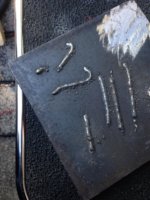tl1988
XS650 Member
So today I started to use my 110v mig /flux welder. i wanted to practice laying down some bead and just get a general idea of welding. Im using .030 flux core wire and layed some bead on a some thick steel plates.
What do you guys think? Any advice to get nicer welds? (i know gas welding gets you better, cleaner welds)
I rather practice with flux till i get decent, consistent welds before moving onto gas.

What do you guys think? Any advice to get nicer welds? (i know gas welding gets you better, cleaner welds)
I rather practice with flux till i get decent, consistent welds before moving onto gas.


